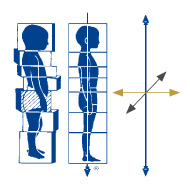Dr. Ida P. Rolf
We do not live on the Moon:
We are addicted to Gravity
Here Rolfing® comes in: The organization of the body is always judged in relation to the gravity, since it is in competition with our body balance:
The body segments - both in a static and dynamic state - should be aligned one above the other in such a way that our balance can be maintained with as little energy expenditure as possible.
So we have to keep our balance - even in spite of a bad posture - in order to get somehow upright through life. To do this, we develop very individual posture and movement patterns.
Here every person has different prerequisites and learned or adopted attitudes that shape and define them individually like:
Family-conditioned posture and movement habits, limited body perception/respect, accidents, operations, seclusion, mental strain, chronic stress, physical overload and a too one-sided lifestyle or training.
Get back into shape with Rolfing® /
Structural Integration
The interaction of gravity, muscular force and elastic force should be balanced.
The balanced body structure / static runs around an imaginary line from the centre of the head to the feet, so that the floor can be felt as a support: If all segments sit there balanced on top of each other, the struggle with gravity is unnecessary.
If imbalanced, a permanently required tension (e.g. of the calves), can strain the neck-shoulder area up to the jaw or even restrict breathing. The fascial network and the musculature then try to stabilise the body in a roundabout way, which restricts flexibility and leads to shortening:
Energy-consuming and tense compensations due to shifts, rotations and tilts of the segments around the three spatial axes become visible and noticeable.
Shortened muscles also lead to compression of e.g. intervertebral discs, menisci and articular cartilage.
But don't worry: No human being is absolutely symmetrical - if only because of the asymmetrical position and size of individual organs.

